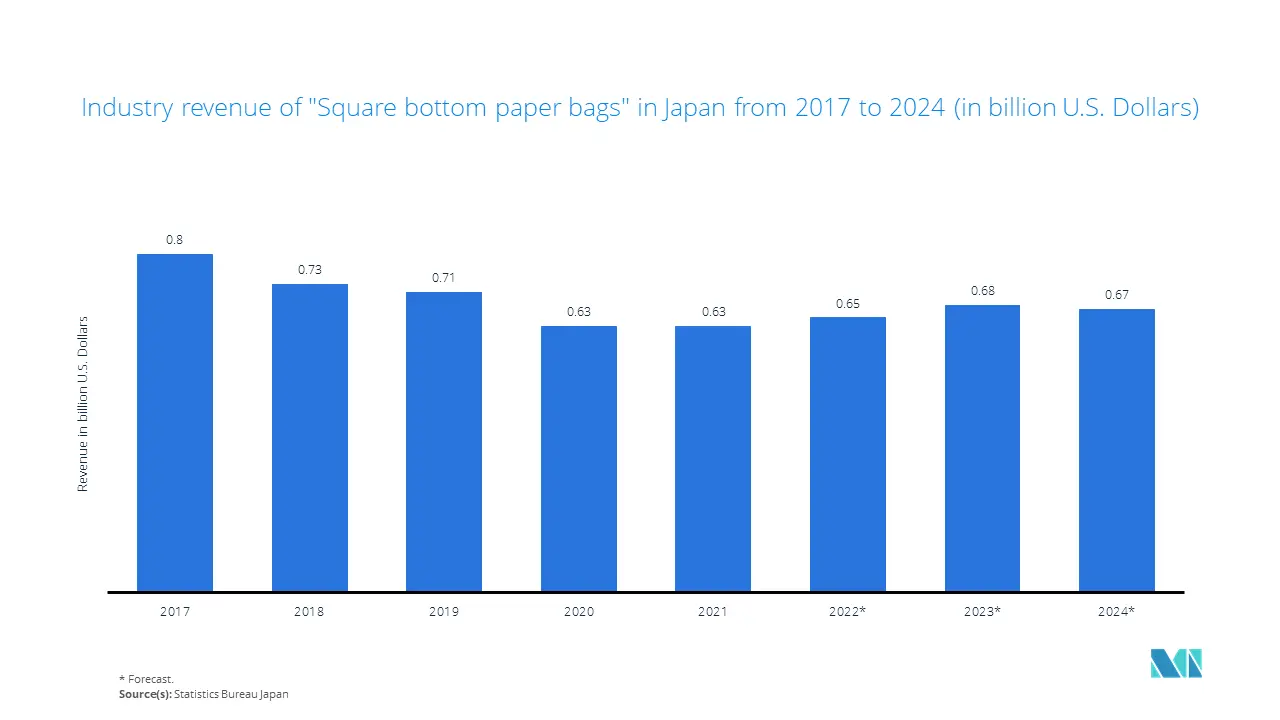Market Trends of Retail Bags Industry
This section covers the major market trends shaping the Retail Bags Market according to our research experts:
Paper Material Segment to Have a Dominant Share in the Market
- The growing preference toward eco-friendly packaging has led retailers to shift focus toward paper-based bag packaging for general public consumers of today and the future as the consumers view paper to be the most eco-friendly alternative to plastic. According to industry experts, plastic takes approximately 100 to 500 years to decompose and causes pollution. Therefore, paper is considered one of the best biodegradable materials for manufacturing retail bags.
- Moreover, the European consumer preferences survey commissioned by Two Sides in 2020 concluded that 62% of consumers see paper and cardboard packaging as better for the environment. Additionally, 70% of consumers surveyed said they were actively taking steps to reduce their use of plastic packaging.
- Furthermore, six different types of paper are used to make retail paper bags, such as kraft paper, white cardboard, offset paper, recycled or eco-friendly paper, and newsprint paper.
- Vendors across the world are prioritizing recycled paper bags to curb deforestation issues in conventional paper production for retail bags. This recycled paper has a similar quality to conventional paper and can be used for making strong bags to contain various retail goods. Also, due to the increasing costs and consumption rates of wood-based paper, consumers are starting to look for alternatives to minimize the impact on the environment. As an alternative, paper made from bamboo or sugarcane is being utilized.
- For instance, Stenqvist provides a carrier bag made from renewable raw material sugarcane and is reusable. In addition, the bags are made available in micron thickness and can be reused. Furthermore, the use of raw materials allows the company to set a smaller carbon footprint and consume 80% fewer fossil resources than virgin materials.
- Further, kraft paper bags are widely being used for groceries, and the material is made of softwood sulfate, which offers various colors such as yellowish-brown, white or cream, and thick light brown color. The bags have a high tensile force and weigh between 80 to 120 grams, ideal for groceries and food takeaways. In addition, the bags are designed to offer different variations such as single, double light, no-rain, and stripes. According to the Japanese Ministry of Economy, Trade, and Industry, exports of craft paper pulps have increased in Japan, which is driving the market.

Asia Pacific to Have a Significant Market Growth
- The Asia Pacific region is supposed to have meaningful growth due to the increasing number of production plants, combined with the growing customer base all over the region, contributing to the growth of the retail bags market. For instance, according to the National Bureau of Statistics of China 2021, China had a total capacity of 7.23 million metric tons production of plastic materials, which is one of the most demanded materials for retail bags.
- The growth of the retail sector in the region is also encouraging the need for retail bags. For example, according to the National Bureau of Statistics of China, the retail business revenue of consumer goods in China amounted to around CNY 3.2 trillion in May 2020.
- Due to the growing need for paper pulp in countries like China and India, the Asia-Pacific region is expected to be the fastest developing region. There is an expansion in the transit packaging division in China, coupled with mounting consumerism heading to a swiftly building demand for retail paper bags.
- The coronavirus outbreak has resulted in an unprecedented impact on the consumer markets across the world due to lockdowns in multiple countries and stay-at-home directives. This has also led to a serious disruption in retail consumption in the region, with most malls and outlets in the region ceasing operations. For instance, according to the Chinese government, retail sales decreased by around 20.5% Y-o-Y during the first two months of 2020. Although there was a slight increase in March, the sales were still down by around 15.8%, when retail operations gradually began to return to normal.
- As of January 2021, the retailers in Singapore that need the customers to pay for plastic bags witnessed a 60% reduction in their plastic bag usage. An industry commitment by the retailers who joined the PACT (Plastic ACTion) Retail Bag Charge initiative, led by the World Wide Fund for Nature (WWF), led to a significant reduction in single-use bags, with more than 300,000 bags saved on a monthly basis. This was an important step taken by the industry to reduce the excessive usage of single-use plastics.
.webp)
